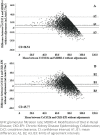Validation of equations to estimate kidney function with and without adjustment by race/color in Brazilian adults (ELSA-Brazil)
- PMID: 38088716
- PMCID: PMC10715322
- DOI: 10.1590/1980-549720230057
Validation of equations to estimate kidney function with and without adjustment by race/color in Brazilian adults (ELSA-Brazil)
Abstract
Objective: To evaluate accuracy and agreement between creatinine clearance (CrCl) measured in 12-h urine and glomerular filtration rate (GFR) calculated by the Modification of Diet in Renal Disease (MDRD-4) and the Chronic Kidney Disease Epidemiology Collaboration (CKD-EPI) formulas, with and without adjustment for race/color.
Methods: Baseline data from the Longitudinal Study of Adult Health (ELSA-Brazil) in adults (35-74 years of age) of both genders were used. Serum creatinine was measured in fasting blood and urinary creatinine was measured in an overnight 12-h urine collect. The agreement between CrCl and the calculated GFR was analyzed by the Bland-Altman method. One-way analysis of variance (ANOVA) with race/color factor was used to verify differences between means of CrCl and GFR with and without correction for race/color. Statistical significance was accepted for p<0.05.
Results: From 15,105 participants in the ELSA-Brazil, 12,813 had a validated urine collect. The Bland-Altman diagrams showed that formulas and CrCl agree with each other with a better accuracy for GFR <90 mL/.min x 1.73m2. The adjustment by race/color increased data dispersion. In this range, one-way ANOVA of CrCl with race/color factor showed similarity between groups (p=0.27).
Conclusion: MDRD-4 and CKD-EPI are useful formulas for screening cases of chronic kidney disease, and correction by race/color, only in blacks or in black and brown subjects, proved to be unnecessary and reduced the reliability of the equations.
Objetivo:: Avaliar a acurácia e a concordância entre o clearance de creatinina (ClCr) medido na urina de 12 h e a taxa de filtração glomerular (TFG) calculada pelas fórmulas Modification of Diet in Renal Disease (MDRD-4) e Chronic Kidney Disease Epidemiology Collaboration (CKD-EPI), com e sem ajuste por raça/cor.
Métodos:: Foram usados dados da linha de base do Estudo Longitudinal de Saúde do Adulto (ELSA-Brasil), em adultos (35–74 anos) de ambos os sexos. A creatinina sérica foi medida no sangue em jejum e a creatinina urinária foi medida na urina de 12 h coletada no período noturno. A concordância entre o ClCr e a TFG calculada pelas fórmulas foi analisada pelo método de Bland-Altman. Análise de variância (ANOVA) de uma via com fator raça/cor foi usada para comparar médias do ClCr e da TFG calculadas com e sem ajuste por raça/cor. A significância estatística foi aceita para p<0,05.
Resultados:: Dos 15.105 participantes do ELSA-Brasil, 12.813 tiveram a coleta urinária de 12 h validada. Os diagramas de Bland-Altman mostraram que as fórmulas e o ClCr concordam entre si e têm melhor acurácia para TFG <90 mL/min/1,73m2, e que o ajuste por raça/cor aumenta a dispersão dos dados. Nessa faixa, a ANOVA de uma via do ClCr com fator raça/cor mostrou semelhança entre grupos (p=0,27).
Conclusão:: MDRD-4 e CKD-EPI são fórmulas adequadas para rastreamento da doença renal crônica na população brasileira, sendo desnecessário o ajuste por raça/cor para o uso desses instrumentos, uma vez que a introdução do ajuste tanto em pretos quanto em pretos e pardos diminuiu a acurácia dos métodos.
Conflict of interest statement
Figures



References
-
- Marinho AWGB, Penha AP, Silva MT, Galvão TF. Prevalência de doença renal crônica em adultos no Brasil: revisão sistemática da literatura. Cad Saúde Colet. 2017;25(3):379–388. doi: 10.1590/1414-462X201700030134. - DOI
-
- Kidney Disease. Improving Global Outcomes. KDIGO 2012 clinical practice guideline for the evaluation and management of chronic kidney disease. KDIGO. 2013;3(1):1–150.
MeSH terms
Substances
LinkOut - more resources
Full Text Sources
Medical

